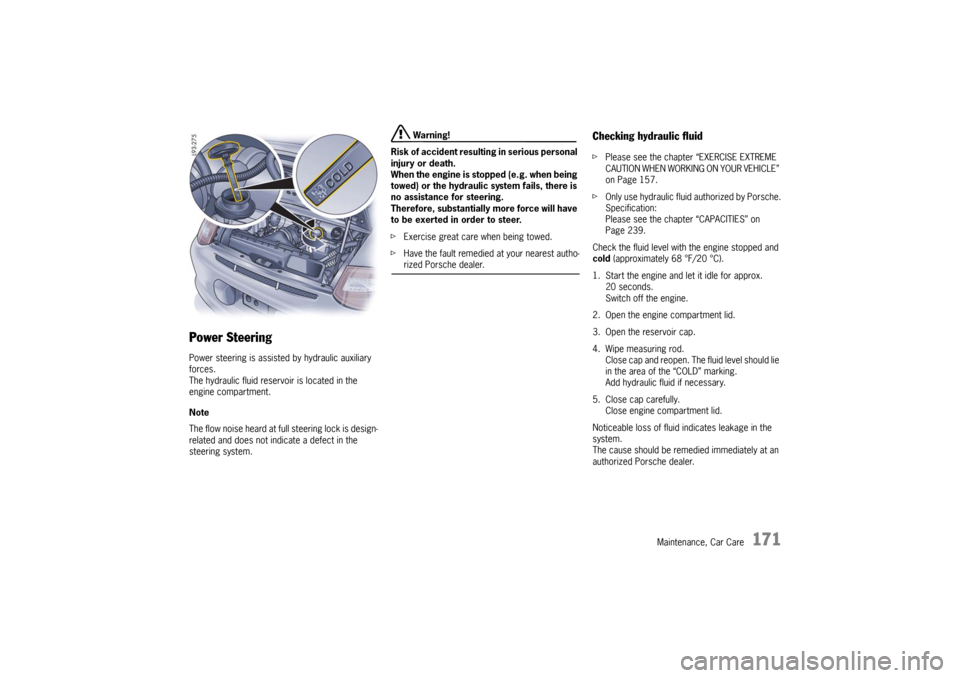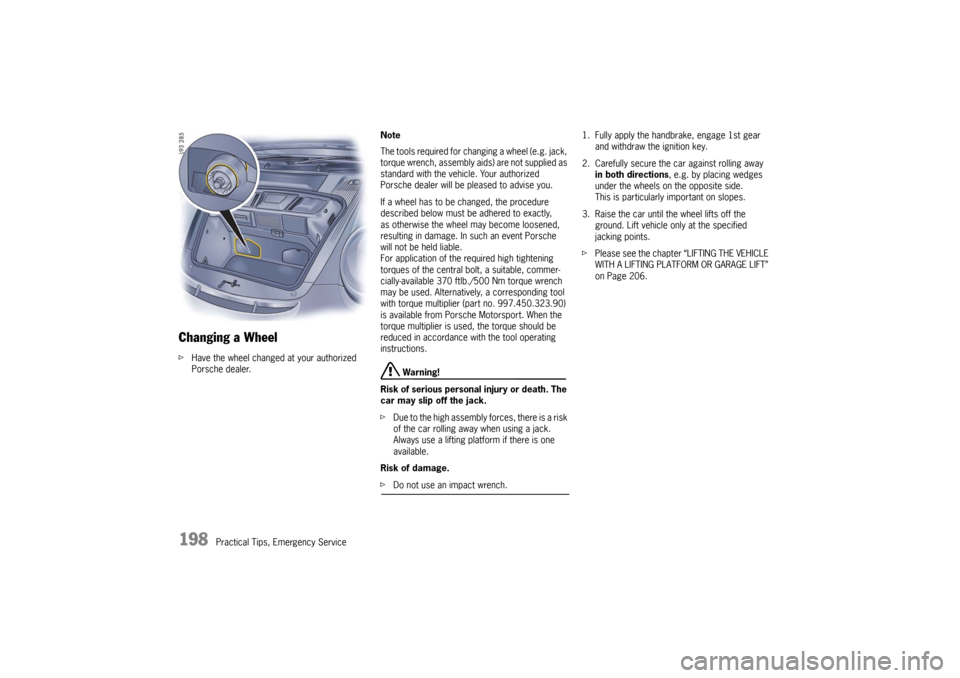warning PORSCHE 911 GT3 2010 5.G Owners Manual
[x] Cancel search | Manufacturer: PORSCHE, Model Year: 2010, Model line: 911 GT3, Model: PORSCHE 911 GT3 2010 5.GPages: 251, PDF Size: 14.33 MB
Page 172 of 251

Maintenance, Car Care
171
Power Steering Power steering is assisted by hydraulic auxiliary
forces.
The hydraulic fluid reservoir is located in the
engine compartment.
Note
The flow noise heard at full steering lock is design-
related and does not indicate a defect in the
steering system.
Warning!
Risk of accident resulting in serious personal
injury or death.
When the engine is stopped (e.g. when being
towed) or the hydraulic system fails, there is
no assistance for steering.
Therefore, substantially more force will have
to be exerted in order to steer.
fExercise great care when being towed.
fHave the fault remedied at your nearest autho-rized Porsche dealer.
Checking hydraulic fluid fPlease see the chapter “EXERCISE EXTREME
CAUTION WHEN WORKING ON YOUR VEHICLE”
on Page 157.
fOnly use hydraulic fluid authorized by Porsche.
Specification:
Please see the chapter “CAPACITIES” on
Page 239.
Check the fluid level with the engine stopped and
cold (approximately 68 °F/20 °C).
1. Start the engine and let it idle for approx.
20 seconds.
Switch off the engine.
2. Open the engine compartment lid.
3. Open the reservoir cap.
4. Wipe measuring rod.
Close cap and reopen. The fluid level should lie
in the area of the “COLD” marking.
Add hydraulic fluid if necessary.
5. Close cap carefully.
Close engine compartment lid.
Noticeable loss of fluid indicates leakage in the
system.
The cause should be remedied immediately at an
authorized Porsche dealer.
10_GT3_21.book Seite 171 Donnerstag, 4. Juni 2009 12:48 12
Page 175 of 251

174
Maintenance, Car Care
Car Care Instructions fPlease see the chapter “EXERCISE EXTREME
CAUTION WHEN WORKING ON YOUR VEHICLE”
on Page 157.
Regular and correct care helps to maintain
the value of your car and is also a precondi-
tion for the New Vehicle Warranty and the
Anti Corrosion Warranty.
Your authorized Porsche dealer has specially
developed car-care products from the
Porsche program available either singly or
as complete car-care sets. They will be
pleased to help you select suitable products.
Whether you use Porsche products or other
commercially available cleaning agents first
make sure of their correct application.
A Porsche that is well-cared for can look like new
for years. It all depends on the amount of care the
owner is willing to give the car.
Warning!
Risk of serious personal injury or damage to
the vehicle or property.
Cleaning agents may be hazardous to your
health.
Most chemical cleaners are concentrates
which require dilution. High concentrations
might cause problems ranging from irritation
to serious injury as well as damage to your
vehicle.
fKeep cleaning agents out of reach from
children.
fObserve all caution labels.
fAlways read directions on the container before
using any product. These directions may
contain information necessary to avoid
personal injury.
fDo not use fuel, kerosene, naphtha, nail polish
remover or other volatile cleaning fluids. They
may be toxic, flammable or hazardous in other
ways. Only use spot removing fluids in a well
vented area.
fDo not clean the underside of chassis,
fenders, wheel covers, etc., without protecting
your hands and arms as you may cut yourself on sharp-edged metal parts.
Moisture and road salt on brakes may affect
braking efficiency.
fTest the brakes after each vehicle washing.
High-pressure cleaning equipment, steam
cleaners
Warning!
High-pressure cleaning equipment or steam
cleaners can damage the following compon-
ents:
–tires,
– logos, emblems,
– painted surfaces,
– alternator.
fPlease observe the operating instructions from
the unit manufacturer.
fWhen cleaning with a flat-jet nozzle or the like,
maintain a minimum distance of 20 inches
(50 cm).
fNever use high-pressure cleaning equipment
or steam cleaners with a round-jet nozzle. A
high-pressure cleaning equipment or steam
cleaners with round nozzle will damage your
vehicle.
fThe tires are particularly susceptible to
damage.
fDo not point the cleaning jet directly at any of the aforementioned components.
10_GT3_21.book Seite 174 Donnerstag, 4. Juni 2009 12:48 12
Page 176 of 251

Maintenance, Car Care
175
Decals
Caution!
Risk of damage due to separation of the
decal films when using high-pressure
cleaning equipment or steam cleaners.
fDo not use high-pressure cleaning equipment or steam cleaners to clean decal films.
Washing The best method of protecting your car from the
damaging effects of the environment is frequent
washing and the application of a preservative. The
underside of your vehicle should also be
thoroughly washed for cinders, salt or sanding at
winter’s end.
The longer salt, road dust and industrial dust,
dead insects, bird droppings or substances from
trees (resin, pollen) are allowed to remain on the
bodywork, the more serious is their harmful
effect.
New cars should be washed carefully with plenty
of clear water to protect the new paint work. Dark
paint finishes show up the smallest of surface
damage (e.g., scratches) more readily than lighter
colors. Dark colors are also more susceptible to
scratching because of the composition of their
pigments and require particularly careful paint
care.
fDo not wash your car in bright sunlight or while
the bodywork is still hot.
fWhen washing by hand, use abundant water, a
soft sponge or wash brush, and Porsche car
shampoo.
fBegin by spraying the body thoroughly with
water to rinse away loose dirt.
fAfter washing, rinse the car with plenty of
water and then dry with a chamois leather.
Do not use the same chamois leather for
drying as you use for cleaning the windshield
and windows.
Warning!
Moisture which gets on to the brakes during
a car wash can reduce braking efficiency or
make the brakes pull unevenly which could
increase the danger of an accident, causing
serious personal injuries or death.
fAfter washing the car, test the brakes and
steering and briefly brake the discs dry.
When doing this, take care not to hamper other
road users behind you (traffic conditions permitting). Automatic car washes
fPlease see the chapter “WIPER BLADES” on
Page 173.
Optional add-on parts or parts which project
beyond the contours of the vehicle may be
damaged by design features (e.g. brushes) of
automatic car washes.
The following parts are particularly
susceptible to damage:
– Windshield wipers (always switch them off to
prevent them wiping unintentionally in intermit-
tent or sensor operation)
– External antennas (always unscrew)
– Rear spoiler
– Wheels (the wider the rim and the lower the tire
height, the greater the risk of damage)
– High-gloss wheels (to prevent these from
getting scratched, do not clean with the wheel-
cleaning brushes of the car wash).
fPlease consult the operator before using
automatic car washes.
fWash and dry by hand all points not reached by
a car wash, such as door and lid seams or
door sills.
10_GT3_21.book Seite 175 Donnerstag, 4. Juni 2009 12:48 12
Page 179 of 251

178
Maintenance, Car Care
Undercoating As it is not possible to exclude the risk of damage
to this protective coating in day to day driving, it
is advisable to have the underside of the car
inspected at certain intervals – preferably before
the start of winter and again in spring – and the
undercoating restored as necessary.
Your authorized Porsche dealer is familiar with the
bodyseal treatment procedures and has the
necessary equipment for applying factory
approved materials. We recommend that you
entrust them with such work and inspections.
Unlike conventional spray oils, undercoating and
rust-proofing compounds based on bitumen or
wax do not attack the sound-proofing materials
applied at the factory.
Warning!
Danger of fire resulting in serious personal
injury or death.
fDo not apply additional undercoating or rust-
proofing on or near the exhaust manifold,
exhaust pipes, catalytic converters or heat
shields. During driving the substance used for undercoating could overheat and ignite.
fBefore applying fresh underseal, carefully
remove any deposits of dirt and grease. Once
it has dried, the new undercoating compound
forms a tough protective coating which
provides efficient rust-proofing of the floor
panels and components. fAlways apply a fresh coating of suitable preser-
vative to unprotected areas after cleaning the
underside of the body, the transmission, the
engine or carrying out repairs to under-body,
engine or transmission components.
Effective rust-proofing is particularly important
during the cold weather season. If your car is
driven frequently in areas where salt has been
spread on the roads, the whole engine compart-
ment should be cleaned thoroughly after the
winter to prevent salt from causing any lasting
damage. A full under-body wash should also be
performed at the same time.
Stainless steel exhaust tailpipesStainless steel exhaust tailpipes can discolor due
to soiling, strong heat, and combustion residues.
The original polish can be achieved again using
commercially available metal polishing paste or
metal polish.
Light alloy wheels fPlease see the chapter “WASHING” on
Page 175.
Warning!
Danger of accident resulting in serious
personal injury or death if cleaning agents
(e.g. wheel cleaning agents) come into
contact with the brake discs.
The resulting film on the brake discs can
impair braking performance.
fMake sure that no cleaning agent comes into
contact with the brake discs.
fIf cleaning agent has come into contact with
the brake discs, thoroughly clean the brake
discs with a strong jet of water.
fPaying attention to any road users behind you,
dry the brake discs by applying the brakes at short intervals.
Pitting may occur if metallic particles which cause
contact corrosion (e.g. brass or copper in brake
dust) are allowed to remain on the aluminum for
too long.
fIf possible, wash the wheels with a sponge or
wash brush about every two weeks. In areas
where salt is spread on winter roads or there is
a lot of airborne industrial dust, it is best to
clean the wheels weekly.
10_GT3_21.book Seite 178 Donnerstag, 4. Juni 2009 12:48 12
Page 181 of 251

180
Maintenance, Car Care
Cleaning airbags covers
Danger!
Risk of danger of serious personal injury or
death if the airbag system is impaired by
improper cleaning work.
fDo not make any modifications whatsoever on
individual components such as the padded
covers of the steering wheel, passenger side
instrument panel, the front seats and the door
linings.
fLet your authorized Porsche dealer clean these components.
Fabric, upholstery, carpets and
floor-mats fUse only a vacuum cleaner or a medium stiff
brush.
fRemove stains and spots with Porsche stain
remover.
The Porsche range of accessories includes
nonskid floor-mats to protect the carpets in
summer and winter.
Warning!
Risk of an accident resulting in serious
personal injury or death.
fAlways check the movement of the pedals
before driving and make sure that they are not
obstructed by a floor-mat or any other object.
fSecure the floor-mat to prevent it from sliding
into positions that could interfere with the safe
operation of your vehicle - do not install them
loosely in the vehicle.
Your Porsche dealer will be glad to offer you nonskid floor-mats of the correct size.
Alcantara fDo not use a leather care product to clean
Alcantara.
For regular care it is sufficient to clean the cover
with a soft brush.
Heavy abrasion or rubbing when cleaning causes
a lasting change in the surface.
Cleaning when lightly soiled
fWet a soft cloth with water or a neutral soap
solution and wipe off the dirt.
Cleaning when heavily soiled
fWet a soft cloth with lukewarm water or
thinned white spirit and dab the dirt from the
outside in. Safety belts If it becomes necessary to clean the belts, you
can use any mild washing agent.
Allow the belts to dry prior to retracting, but avoid
direct sunlight.
fOnly use suitable cleaners.
If unsuitable cleaners are used or any attempt
is made to dye or bleach the belts, the
webbing may be weakened and thus constitute
a safety risk.
10_GT3_21.book Seite 180 Donnerstag, 4. Juni 2009 12:48 12
Page 186 of 251

Practical Tips, Emergency Service
185
Treadwear
The treadwear grade is a comparative rating
based on the wear rate of the tire when tested
under controlled conditions on a specific govern-
ment test course.
For example, a tire graded 150 would wear one
and a half (1-1/2) times as well on the government
course as a tire graded 100.
The relative performance of tires depends upon
the actual conditions of their use, however, and
may depart significantly from the norm due to var-
iations in driving habits, service practices and dif-
ferences in road characteristics and climate.
Traction AA, A, B, C
The traction grades, from highest to lowest, are
AA, A, B, and C and they represent the tire’s ability
to stop on wet pavement as measured under
controlled conditions on specified government
test surfaces of asphalt and concrete.
A tire marked C may have poor traction perfor-
mance.
Warning!
The traction grade assigned to this is based on
braking (straight-ahead) traction tests and does
not include cornering (turned) traction, accelera-
tion, hydroplaning or peak traction characteris-
tics. Temperature A, B, C
The temperature grades are A (the highest), B and
C, representing the tire’s resistance to the genera-
tion of heat and its ability to dissipate heat when
tested under controlled conditions on a specified
indoor laboratory test wheel.
Sustained high temperatures can cause the
material of the tire to degenerate and reduce tire
life, and excessive temperature can lead to
sudden tire failure.
The grade C corresponds to a level of perfor-
mance which all passenger car tires must meet
under the Federal Motor Vehicle Safety Standard
No. 109.
Grades B and A represent higher levels of perfor-
mance on the laboratory test wheel than the
minimum required by law.
Warning!
The temperature grade for this tire is established
for a tire that is properly inflated and not
overloaded.
Excessive speed, underinflation, or excessive
loading, either separately or in combination, can
cause heat buildup and possible tire failure, resul-
ting in serious personal injury or death.
Tire pressures
Warning!
Incorrect tire pressure causes increased tire
wear and adversely affects road handling.
This could lead to tire failure, resulting in loss
of control, leading to serious personal injury
or death.
fAlways use an accurate tire pressure gauge
when checking inflation pressures.
fDo not exceed the maximum tire pressure
listed on the tire sidewall.
Please see the chapter “TIRE PRESSURE
PLATE” on Page 235.
fCold tire inflation pressure means: all tires
must be cold, ambient temperature maximum
(68 °F/20 °C)
, when adjusting the inflation
pressure.
Avoid sunlight striking the tires before measu-
ring cold pressures, since the pressures would
rise from temperature influence.
fValve caps protect the valve from dust and dirt,
and thus from leakage.
Always screw caps tightly down.
Replace missing caps immediately.
fUse only plastic valve caps.
fDo not use commercially available sealant or
tire inflating bottles. Only use Porsche approved tire sealant.
10_GT3_21.book Seite 185 Donnerstag, 4. Juni 2009 12:48 12
Page 188 of 251

Practical Tips, Emergency Service
187
B Vehicle load limit
Is the maximum total weight limit specified of
the load (passengers and cargo) for the
vehicle. This is the maximum weight of passen-
gers and cargo that can be loaded into the
vehicle.
Please see the chapter “LOADING INFORMA-
TION” on Page 195.
C Tire size for the front axle
Check with your authorized Porsche dealer
about the current release status.
D Recommended tire pressure for the front axle
These values are for cold tires (68 °F/20 °C).
E Tire size for the rear axle
Check with your authorized Porsche dealer
about the current release status.
F Recommended tire pressure for the rear axle.
These values are for cold tires (68 °F/20 °C).
G In vehicles with collapsible spare wheel:
Size and tire pressure of the spare wheel.
Tire traction
Warning!
When driving on wet or slushy roads, a
wedge of water may build up between the
tires and the road. This phenomenon is
known as “hydroplane” and may cause
partial or complete loss of traction, vehicle
control or stopping ability.
fReduce speed on wet surface to prevent this. Tire life Tire life depends on various factors, i. e., road
surfaces, traffic and weather conditions, driving
habits, type of tires and tire care.
fInspect your tires for wear and damage before
driving off. If you notice uneven or substantial
wear, wheels might need alignment or tires
should be balanced or replaced.
Tire wear The original equipment tires on your Porsche have
built-in tire wear indicators. They are molded into
the bottom of the tread grooves and will appear as
approximately 1/2 in. (12 mm) bands when the
tire tread depth is down to 1/16 of an in.
(1.6 mm).
When the indicators appear in two or more
adjacent grooves, it is time to replace the tires.
We recommend, however, that you do not let the
tires wear down to this extent.
Worn tires cannot grip the road surface properly
and are even less effective on wet roads.
In the United States, state laws may govern the
minimum tread depth permissible. Follow all such
laws.
10_GT3_21.book Seite 187 Donnerstag, 4. Juni 2009 12:48 12
Page 190 of 251

Practical Tips, Emergency Service
189
Danger!
Risk of serious personal injury or death.
Driving the vehicle with low tire pressure
increases risk of a tire failure and resulting
loss of control. Furthermore, low tire
pressure increases rate of wear of the
affected tires.
fCheck tires – including sidewalls – regularly for
foreign bodies, nicks, cuts, cracks and bulges.
fAfter driving off road, examine tires for signs
of damage such as cuts, tears, bulges or
foreign objects stuck in the tread. Replace a
damaged tire if necessary.
fCross curb edges slowly and at right angles if
possible.
Avoid driving over steep or sharp curbs.
fIn cases of doubt, have the wheel (particularly
the inner side) checked by an authorized Porsche dealer.
Tire replacements If in doubt, contact your authorized Porsche
dealer.
Use only tire makes and types approved by
Porsche.
If you do not use a Porsche recommended
replacement tire, make sure that you
purchase your new tires from a reputable tire
dealer and that the dealer complies with all
manufacturers warnings for those tires.
Only tires with the same make and with the
same specification code (e.g. “N0”, “N1”...)
can be mounted.
Before mounting new tires, check with your
Porsche dealer about the current release
status.
Use tires with “ZR” quality standards. There
are currently no standards concerning tire
strength at speeds above 150 mph (240 km/h).
Tires should be replaced no less than on one axle
at the time.
Only tires of the same make and type must be
used. Mixed tires are not permissible.
Initially, new tires do not have their full traction.
You should therefore drive at moderate speeds
during the first 60 - 120 miles (100 - 200 km). If new tires are installed only on one axle, a notice-
able change in handling occurs due to the different
tread depth of the other tires.
This happens especially if only rear tires are
replaced. However, this condition disappears as
the new tires are broken in.
fPlease adjust your driving style accordingly.
Installation of new tires should only be done by a
qualified tire technician.
Valves
Please observe the installation and replacement
instructions for valves.
fUse only genuine Porsche metal valves.
fProtect the valve inserts against soiling with
valve caps.
Soiled valve inserts can cause a gradual loss
of air.
fUse only plastic valve caps.
10_GT3_21.book Seite 189 Donnerstag, 4. Juni 2009 12:48 12
Page 191 of 251

190
Practical Tips, Emergency Service
Parking at the curb
Warning!
Hard impacts against curbs (or traffic
islands) are dangerous and may cause
hidden tire damage which is not noticeable
until later. Such damage can result in
accidents at high speeds causing serious
personal injury or death.
Depending on the force of impact, the edge
of the rim can also be damaged.
fIf you are in doubt, have the wheel checked by
an expert, particularly if you suspect damage
on the inside.
fIf you must drive over a curb or other obstacle,
drive slowly and at an obtuse angle. Exercise care when parking along curbs.
Wheel alignment, wheel balancing As a precaution, have wheels with summer tires
balanced in the spring, and those with mud and
snow tires before winter.
Unbalanced wheels may affect car handling and
tire life.
Only the specified weights may be used for wheel
balancing.
Self-adhesive weights must not come into contact
with cleaning agents, since they could drop off.
Uneven tread wear indicates wheel imbalance. In
this event, the vehicle should be checked at an
authorized Porsche dealer.
Warning!
If, during a trip, uneven running or vibrations
occur that could be caused by damage to
tires or the car, the speed must be reduced
immediately, but without braking sharply.
If you continue your trip without having the
cause of the fault remedied, you might lose
control of your vehicle which could cause
serious personal injury or death.
fStop the vehicle and check the tires.
fIf no cause for the fault can be found, drive
carefully to the nearest authorized Porsche dealer.
Wheels with Tire Pressure Monitoring
(TPM) sensorsBefore changing wheels, make sure that the
wheels are compatible with your vehicle's TPM.
fCheck this with your authorized Porsche
dealer.
10_GT3_21.book Seite 190 Donnerstag, 4. Juni 2009 12:48 12
Page 199 of 251

198
Practical Tips, Emergency Service
Changing a WheelfHave the wheel changed at your authorized
Porsche dealer.Note
The tools required for changing a wheel (e.g. jack,
torque wrench, assembly aids) are not supplied as
standard with the vehicle. Your authorized
Porsche dealer will be pleased to advise you.
If a wheel has to be changed, the procedure
described below must be adhered to exactly,
as otherwise the wheel may become loosened,
resulting in damage. In such an event Porsche
will not be held liable.
For application of the required high tightening
torques of the central bolt, a suitable, commer-
cially-available 370 ftlb./500 Nm torque wrench
may be used. Alternatively, a corresponding tool
with torque multiplier (part no. 997.450.323.90)
is available from Porsche Motorsport. When the
torque multiplier is used, the torque should be
reduced in accordance with the tool operating
instructions.
Warning!
Risk of serious personal injury or death. The
car may slip off the jack.
fDue to the high assembly forces, there is a risk
of the car rolling away when using a jack.
Always use a lifting platform if there is one
available.
Risk of damage.
fDo not use an impact wrench.1. Fully apply the handbrake, engage 1st gear
and withdraw the ignition key.
2. Carefully secure the car against rolling away
in both directions, e.g. by placing wedges
under the wheels on the opposite side.
This is particularly important on slopes.
3. Raise the car until the wheel lifts off the
ground. Lift vehicle only at the specified
jacking points.
fPlease see the chapter “LIFTING THE VEHICLE
WITH A LIFTING PLATFORM OR GARAGE LIFT”
on Page 206.
10_GT3_21.book Seite 198 Donnerstag, 4. Juni 2009 12:48 12